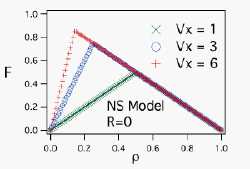|
Standard Model of Nagel and Schreckenberg 2
|
|
We first examin the case of R = 0. In the right, fundamental diagram is shown for the speed limits U = 1, 3, 6. The all graphs are of triangular shapewith different pinacle locations. If we write the value of the density at the pinacle as \rho^*, the traffic flows differently at \rho < \rho^* and at \rho > \rho^*. Below \rho^*, F(\rho) is a linearly increasing function given by |
 |
|
F = U . \rho
|
(4.4)
|
As is evident from the relation between F and Vav, (4.4) means that all cars runs at the highest allowed velocity U. We call this a free traffic, since the presence of other cars is not felt here.
Above the critical density \rho^*, however, F is independent of U and follows a line
|
F = 1- \rho
|
(4.5)
|
At higher density, the traffic congestion becomes worse, and efficiency of the traffic decreases. So it is bad for the driver, bad for the traffic if we bring in more cars above the critical denity. Since the velocity Vav= F /\rho decreases even faster, it is needless to say that dissatisfaction of drivers get worse. From (4.4) and (4.5), we obtain the following expression for the critical density
|
\rho^* = 1/(U+1)
|
(4.6)
|
Therefore, the critical density above which traffic congestion starts can be controlled by the setting of speed limit U. With larger U, traffic jam starts with smaller \rho, but the flux is lager than that obtained from smaller U, and thus the traffic is more efficient with higher U. Since the congestion puts pressure on drivers. The road administrators undoubtedly would like higher speed limit. So the situation could be thought as a dilemma. The application of this conclusion to the reality is premature, however, since we have not included the such effects as the increase of accident.